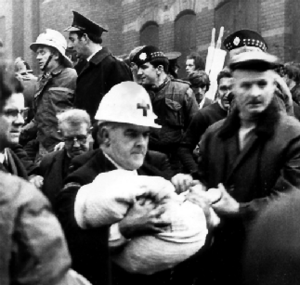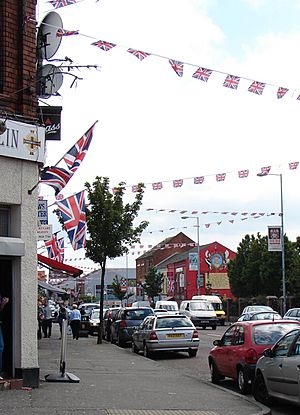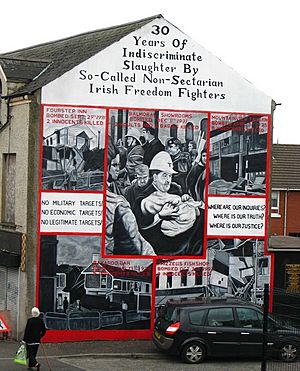1971 Balmoral Furniture Company bombing, Shankill facts for kids
Quick facts for kids 1971 Balmoral Furniture Company bombing, Shankill |
|
|---|---|
| Part of the Troubles | |

Leading Ambulanceman Bob Scott removes the body of the youngest victim, Colin Nichol, from under the rubble
|
|
| Location | Balmoral Furniture Company showroom, Lower Shankill Road, Belfast, Northern Ireland |
| Date | 11 December 1971 12.25 p.m. |
|
Attack type
|
Bombing |
| Deaths | 4 civilians |
|
Non-fatal injuries
|
19 |
The Balmoral Furniture Company bombing was a violent attack that happened on 11 December 1971. It took place on Shankill Road in Belfast, Northern Ireland. Four people died in the attack.
On that day, a bomb exploded without warning outside a furniture store. This store was on the Shankill Road, an area where most people supported staying part of the United Kingdom. The explosion killed four civilians, including two babies. Many believe the attack was carried out by the Provisional Irish Republican Army (IRA). This was likely in revenge for the Ulster Volunteer Force (UVF) bombing of McGurk's Bar a week earlier. That attack had killed 15 Catholic civilians.
The bombing happened on a Saturday when the Shankill Road was very busy with shoppers. This caused a lot of chaos in the area. Hundreds of people quickly came to help British Army soldiers and the Royal Ulster Constabulary (RUC). They worked to rescue people trapped under the broken building. A journalist named Peter Taylor said the bomb site looked like the "London Blitz" during World War II. This attack made many people in the close-knit Ulster Protestant community very angry. Many men later said the bombing was why they joined loyalist armed groups. These groups included the illegal UVF or the Ulster Defence Association (UDA), which was legal at the time. Some of these men were Tommy Lyttle, Michael Stone, Sammy Duddy, and Billy McQuiston.
This bombing, along with the McGurk's Bar bombing, helped start a cycle of revenge attacks. These attacks involved bombings and shootings by both loyalist and republican groups. This made the 1970s the most violent decade in the 30-year history of the Troubles.
The Balmoral Bombing Event
At 12:25 PM on 11 December 1971, the Shankill Road was full of Saturday shoppers. A green car stopped outside the Balmoral Furniture Company. This shop was at the corner of Carlow Street and Shankill Road. People in the area often called the shop "Moffat's."
One person got out of the car and left a box with a bomb inside on the step. The person then got back into the car, and it quickly drove away. The bomb exploded just moments later. The blast caused most of the building to fall down. It collapsed on top of people inside the shop and those walking by outside.
Four people died because of the huge explosion. This included two babies: Tracey Munn, who was 2 years old, and Colin Nichol, who was 17 months old. Both babies died instantly when part of a wall crashed down on the pram they were sharing. Two employees working inside the shop also died: Hugh Bruce, aged 70, and Harold King, aged 29. Hugh Bruce was Protestant, but Harold King was Catholic. Bruce, a former soldier, worked as the shop's doorman. He was closest to the bomb when it exploded.
Nineteen people were hurt in the bombing, including Tracey's mother. The building was very old, built in Victorian times. Its walls supported the upper floors. Because of this, it could not stand up to the blast and collapsed. This made the damage and the number of injuries much worse.
The bombing caused total confusion in the busy street. Hundreds of people rushed to the scene. They formed human chains to help the British Army and RUC. They dug with their bare hands to free those trapped under the rubble. Peter Taylor said the scene looked like the "London Blitz" from World War II.
One person who saw the aftermath was Billy McQuiston. He was walking on the Shankill Road with a friend when they heard the explosion. McQuiston rushed to the scene. He later described what he saw and how he felt at the wrecked building:
Women were crying. Men were trying to dig out the rubble. Other men were hitting the walls. One person was crying beside you and the next person was shouting 'Bastards' and things like that. I didn't actually see the babies' bodies as they had them wrapped in sheets, but the blood was just coming right through them. They were just like lumps of meat, you know, small lumps of meat. All these emotions were going through you and you wanted to help. There were people shouting at the back, "Let's get something done about this". To be perfectly honest with you, I just stood there and cried, just totally and utterly numb. It wasn't until I got back home that I realised, this isn't a game. There's a war going on here. These people are trying to do us all in. They're trying to kill us all and they don't care who we are or what age we are. Because we're Protestants, they are going to kill us so we're going to have to do something here.
The angry crowd at the scene felt the same shock and anger as McQuiston. They blamed the IRA for the bombing right away. They also tried to get revenge on any Catholic person they found. A Protestant man nearby made a comment about the bombing. Someone who heard him thought he was Catholic and shouted, "He's Catholic!" A large group of about one hundred men and women ran towards him. They started kicking and punching him until he was unconscious. It took the RUC and British troops half an hour to rescue him from his attackers.
Aftermath of the Attack
No group officially said they were responsible for the attack. However, the Provisional IRA was immediately and widely blamed. In his book Loyalists, Peter Taylor explained that the Provisional IRA bombed Balmoral as revenge. This was for the McGurk's Bar bombing that happened one week earlier. That attack had killed 15 Catholic civilians. Author Susan McKay also supports this idea.
Billy McQuiston, along with many other Protestant men who were on the Shankill at the time, joined the Ulster Defence Association (UDA) right away. Others included Sammy Duddy, Michael Stone, and Tommy Lyttle. Lyttle, who became a leader of the UDA West Belfast Brigade, was not there. But his wife and two daughters were near the bomb when it exploded. They were not hurt, but his daughter Linda said Lyttle "took it personally." Jackie McDonald, who is now a UDA leader in South Belfast, worked as a manager for the Balmoral Furniture Company. John White, a leader of the Ulster Freedom Fighters (UFF, a name the UDA used for attacks), used the Balmoral bombing to justify his own violent actions later.
Within a month of the bombing, the UDA changed its structure. It became more like a military group. It set up a thirteen-member Security Council under Charles Harding Smith to plan its activities.
Michael Stone later carried out the Milltown Cemetery attack in 1988. This attack was even filmed. Another Protestant man, Eddie Kinner, was at the scene after the explosion. He lived very close to Balmoral. He wanted revenge against the IRA and later joined the Ulster Volunteer Force (UVF). He later spoke about his feelings after the Balmoral bombing in an interview with Peter Taylor. He said, "On that occasion, if somebody had handed me a bomb to plant it anywhere you want in the Falls, I would have done it." He added that he would not have hesitated to take someone's life.
Within a week of the attack, the UVF got revenge. They planted a bomb at Murtagh's Bar on the Irish nationalist Springfield Road in west Belfast. A 16-year-old Catholic barman, James McCallum, was killed.
The building where Balmoral's Furniture Company was located used to be a cinema called "Wee Joe's Picture House." It dated back to the 1930s. It was named after "Wee" Joe McKibben, one of the cinema's owners. People locally said it cost a jam jar to get in. This was because customers could go to McKibben's grocery shop and trade an empty jam jar for a cinema ticket. The building was torn down after the bombing.
Even though a young person on the Shankill had seen the green car and the person who planted the bomb, the bombers were never caught. No one was ever charged in connection with the attack. The McGurk's Bar bombing and the Balmoral bombing helped start a cycle of revenge attacks. These attacks by loyalist and republican armed groups made the 1970s the most violent decade in the 30-year history of the Troubles.
The Balmoral bombing was not the first attack in the Shankill Road area. On 29 September 1971, the Four Steps Inn pub was bombed by the Provisional IRA. Two men died in that attack. It was also not the last attack. In August 1975, the Provisional IRA carried out a shooting and bombing attack against the Bayardo Bar on Aberdeen Street. This killed three men and two women, one of whom was 17 years old. A more deadly attack happened on 23 October 1993. A two-man IRA unit from Ardoyne carried a bomb into Frizzell's Fish Shop on the Shankill. The bomb went off too early. It killed one of the bombers and ten customers (see Shankill Road bombing).
1976 Balmoral Bombing
The Balmoral company itself became a target after this attack. In October 1976, its building in Dunmurry was blown up in another bomb attack. No one was hurt in this second attack. Three IRA members were arrested near the scene. One of them, Bobby Sands, was sent to prison for having a gun because of this incident. Sands' fellow hunger striker, Joe McDonnell, was also arrested after this event. Sands and McDonnell had planned the bomb attack together.




